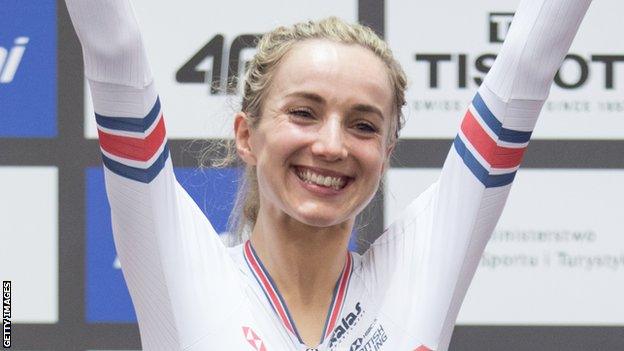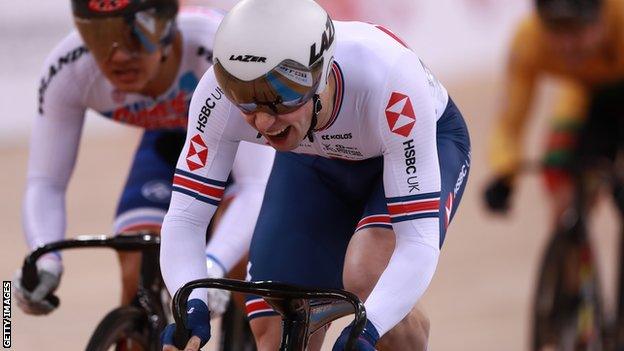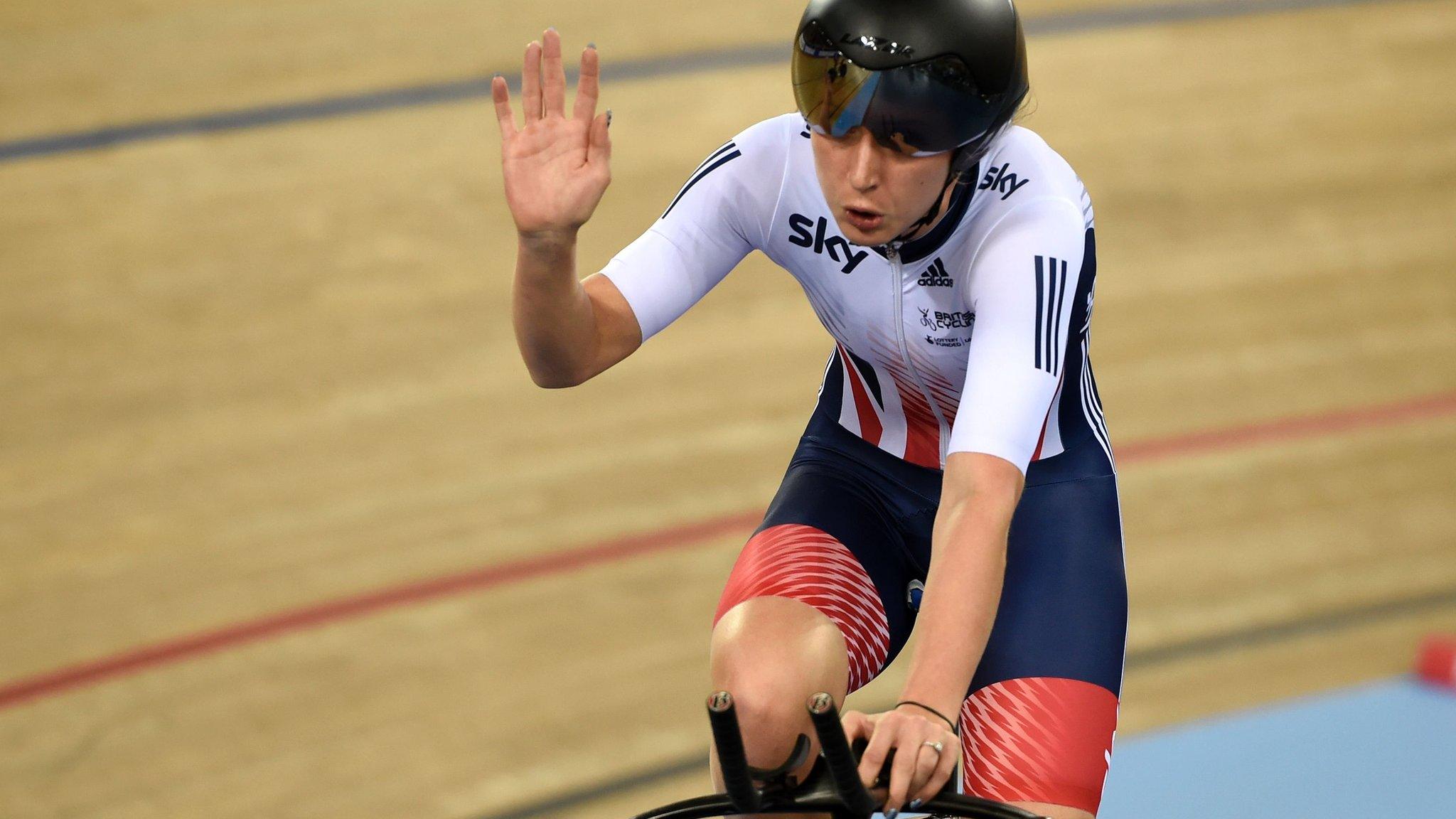Track Cycling World Championships 2020: The events explained
- Published

Elinor Barker won Great Britain's sole gold medal at the 2019 Track Cycling World Championships in Pruszkow
UCI Track Cycling World Championships |
|---|
Venue: Berlin Velodrome, Germany Dates: 26 February-1 March |
Coverage: Live on BBC Two, BBC Four, BBC Red Button, BBC iPlayer, BBC Sport website and app and through Connected TVs. |
Don't know your madison from your omnium? Confused by the keirin? Wondering just how the points race works?
Here is BBC Sport's guide to the Track Cycling World Championships in Berlin.
Points race
A mass-start race of 40km (160 laps) for men and 25km (100 laps) for women. Points are scored in intermediate sprints, which are held every 10 laps, with five points for the winner followed by three, two and one for the next three over the line. There are also 20 points on offer for lapping the field.
Tactics vary, with some riders sitting at the back to conserve energy and contest the intermediate sprints, while others try to gain a lap by breaking off the front and rejoining the back of the main bunch. The winner is the rider with the most points at the end of the race.
Madison
Perhaps the most confusing track cycling event to follow, the madison - named after Madison Square Garden in New York, where the event was first held - is similar to the points race but with teams of two riders.
The madison will be included in the Olympic programme at Tokyo 2020 for the first time since 2008, where women will compete in the event for the first time.
Women will race over 30km (120 laps), while the men race 50km (200 laps). Intermediate sprints are held every 10 laps, with five points for the winner followed by three, two and one for the next three over the line - while these points are doubled for the final sprint at the end of the race. Teams can also earn 20 points by gaining a lap on the main bunch.
One rider is always active, while the other continues to ride round, but is effectively 'resting' at the top of the track. When the active rider needs a breather, around every lap and a half or so, they 'hand-sling' their partner into the action. The best madison duos have an endurance rider capable of gaining a lap and a sprinter to win points.
With all teams racing at the same time, trying to gain a lap on their rivals or win sprints, it is quite an impressive spectacle. The team with the most points at the end of the race is the winner and if there is a draw on points, places in the final sprint determine the winner.
Omnium
The omnium has had a major overhaul following the Rio 2016 Olympics, changing from a six-race event over two days to a four-race event held on a single day.
All three individual timed events have been dropped. The format now consists of four bunch races, with the scratch, elimination and points races retained alongside the tempo race. This has transformed the omnium into a pure endurance event instead of a test of sprinting and endurance.
Points are accumulated by riders in the first three events - the scratch, tempo and elimination races - with 40 points for the winner, 38 for second, 36 for third and so on.
Each point then won during the final event - the points race - is added to the rider's points total. The rider with the highest score at the end of the points race is the winner.
Scratch race - a 10km (40 lap) race for men and 7.5km (30 lap) race for women, where the winner is the first rider over the line.
Tempo race - a 10km (40 lap) race for men and 7.5km (30 lap) race for women, with sprints conducted every lap after the first five laps. The winner of each sprint earns one point and any rider who gains a lap on the bunch earns four points.
Elimination race - the last rider to cross the finish line every second lap is eliminated until one rider is left.
Points race - 25km (100 laps) for men and 20km (80 laps) for women. Same rules as the individual points race.

Six-time Olympic gold medallist Jason Kenny is competing in Berlin
Team pursuit
The men's and women's teams both comprise four riders, racing over 4km. Two teams are on the track at the same time, one starting on the back straight, one on the home straight. The rules are simple - complete the distance in the quickest time possible, or catch your opponents to win.
Drafting is crucial with riders racing millimetres behind each other. The time is stopped when the front wheel of the third rider crosses the line. This allows one member of the team to drop out during the race. Qualifying rounds now feature two teams on the track at once instead of one.
Individual pursuit
A straight race against the clock over 4km for men and 3km for women. As with the team pursuit, one rider starts on the back straight, one on the home straight but they are competing against the clock rather than each other.
The quickest two riders in qualifying contest the final, where to win you must catch the other rider or be first to complete the distance.
Team sprint
The men's race is a three-lap, three-rider team time trial. After each lap, one rider drops out, leaving one man to race the final lap on his own. The women's race is a two-lap, two-rider affair.
The quickest eight teams in qualifying proceed to the first competition round and the fastest two teams from that round compete against each other in the final for the gold medal, with the next two fastest going through to race for the bronze medal.
Sprint
To qualify for the knockout rounds, riders must complete a 200m flying lap in the fastest time possible with 32 progressing.
The time trial is followed by knockout heats - fastest versus slowest. These races are 750m long but only the final 200m are timed, with the winner being the first across the line.
From the quarter finals the riders race best of three heats. The knockout races tend to feature slow, tactical starts, followed by a frenetic finish as two riders race against each other with the first to cross the line winning - the perceived advantage being that the rider coming from behind can draft, using less energy and thus have a better chance of being victorious.
Scratch race
The men race over 15km, the women 10km - the simplest of races. There are no intermediate sprints or points to be won. The winner is the first rider to cross the finish line.
Keirin
Developed in Japan for gambling purposes, the keirin is a tactical race that starts behind a motorised bike, called a derny, which gradually increases its pace to about 50km/h for men and 45km/h for women, until it pulls off to signal a sprint for the line.
The format has been tweaked following controversy in Rio 2016 men's final - won by Britain's Jason Kenny - which had to be restarted twice due to infringements.
The race is now 1.5km (six laps) in total, instead of 2km, but the sprint distance has been increased from two and a half laps to three laps.
Riders now also have to stay behind the leading edge of the front wheel of the derny - rather than the rear edge of the rear wheel - before the pacer pulls off.
Time trial
A 1km race for the men (also known as the kilo) and 500m for the women, with riders going off from a standing start.
Qualifying rounds see two riders on the track at the same time, with the top eight going through. In the finals, each rider competes alone and the quickest time wins.
- Published10 April 2017

- Published14 April 2017

- Published19 July 2016
